Embark on a culinary journey like no other as we dive into the rich tapestry of Malaysian traditions and flavors during the vibrant celebrations of Eid Ul Fitr. Join us as we unravel the captivating tales of two beloved delicacies that steal the spotlight during this joyous occasion – the exquisite Ketupat and the irresistible Dodol.
From the intricacies of their preparation to the cultural significance they hold, discover the magic that makes Ketupat and Dodol the most sought-after treats that grace the tables of festivities across Malaysia. Prepare to indulge in a feast for the senses as we explore the uniqueness and charm of these iconic Eid Ul Fitr gastronomic delights.
Ketupat Chronicles: Unveiling The Mysteries Of Malaysia’s Exquisite Rice Cakes
Introduction to Ketupat: An Enchanting Culinary Journey
Embark on a flavourful adventure as we delve into the captivating world of ketupat, a beloved staple food in Malaysia. These steamed, compressed rice cakes wrapped in woven palm leaves are not only a culinary delight but also hold deep cultural significance. Join us as we unravel the secrets of Malaysia’s exquisite ketupat, a dish that brings people together during the holy month of Ramadan and joyous Eid al-Fitr celebrations.
The Four Pillars of Ketupat Artistry
Prepare to be enchanted as we explore the mesmerizing artistry behind four of the most popular ketupat varieties found in Malaysia:
- Ketupat Nasi – The White Wonder
- Ketupat Palas – A Taste of Coconut Magic
- Ketupat Burasak – A Fiery Symphony of Flavors
- Ketupat Sotong – A Seafood Extravaganza
Through each mouthwatering variety, we’ll uncover the intricate preparation methods, unrivaled textures, and irresistible flavors that make ketupat a culinary treasure. Get ready to immerse yourself in a world of culinary delights that will leave you craving more!
Ketupat Nasi: A Diamond in the Rice Fields
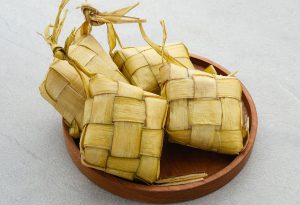
Discover the elegance of ketupat nasi, a delicate creation made from white rice that oozes with simplicity and perfection. As we uncover the secrets of its preparation, you’ll witness the transformation of uncooked rice into a compressed masterpiece. Dive into the soft, chewy texture as you indulge in the tantalizing blend of flavors when paired with mouthwatering rendang and stews. Allow yourself to be transported to a world of culinary bliss as ketupat nasi takes center stage.
Ketupat Palas: Unleashing the Essence of Coconut
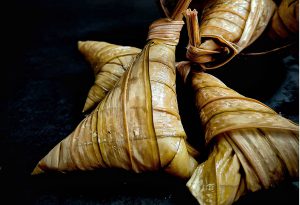
Experience the magic of ketupat palas, a culinary marvel that showcases the true essence of coconut. Delight in its fan-like shape, meticulously woven from young coconut leaves, and savor the sticky, chewy texture that encapsulates the essence of traditional Malaysian must have dishes during Eid-Ul Fitr Celebration. Let the aroma of glutinous rice with coconut transport you to the vibrant east coast states of Malaysia, where ketupat palas reigns supreme.
Ketupat Burasak: Igniting the Flame of Flavor
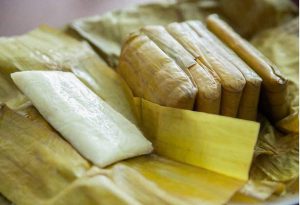
Ignite your taste buds with the explosive flavors of ketupat burasak. Originating from the northern Malay states, this rectangle-shaped rice cake wrapped in banana leaf casing offers a unique combination of taste and texture. Succulent, savory, and infused with a spicy coconut milk gravy, ketupat burasak is a festive dish that embodies the vibrant culinary traditions of Malaysia. Prepare to be enthralled by the symphony of flavors that unfolds with each delectable bite.
Ketupat Sotong: Dancing with the Sea
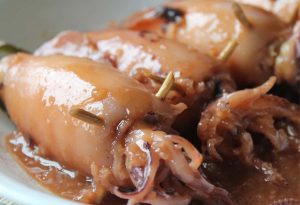
Immerse yourself in the world of ketupat sotong, where the magic of the ocean meets the art of rice making. Delight in the bouncy texture and seafood-infused flavors that come to life as the rice is packed into cuttlefish shells. Take a culinary voyage with each bite as the flavors of squid, prawns, and exotic spices dance on your palate. Ketupat sotong is the perfect appetizer or side dish that will transport you to the picturesque coastal landscapes of Malaysia.
A Tapestry of Flavors and Traditions
As we celebrate the diversity of ketupat, we uncover the distinctive characteristics that set each variety apart. Ketupat nasi, a versatile everyday delicacy, stands tall with its fluffy texture and mild flavor. Ketupat palas delights in its morning glory, offering a sticky, sweet rice sensation. Ketupat burasak ignites festive occasions with its flavorful fish and coconut filling. Finally, ketupat sotong takes center stage, showcasing the harmonious union of seafood and rice. Indulge in the rich tapestry of flavors that Malaysia’s ketupat traditions have to offer!
A Celebration of Culture and Unity
Beyond its culinary allure, ketupat holds deep cultural significance for Malaysians. Explore the cherished tradition of gathering together to weave palm leaves, symbolizing family unity and hospitality. Discover the joy of breaking fast during Ramadan with ketupat as a symbol of care, respect, and togetherness. Experience the spirit of peace and unity as ketupat takes its rightful place at festive gatherings, where traditions are shared and cherished. Allow the nostalgia of Eid festivities to wash over you as ketupat becomes a beacon of cultural pride.
Ketupat: A Nutritional Delight
Immerse yourself in the nutritional benefits of ketupat, a rice dish that packs a punch. From its complex carbohydrates that provide sustained energy release to its fiber-rich content that supports digestion, ketupat is a nutritional powerhouse. Delve into the plethora of vitamins, minerals, and healthy fats found in ketupat and discover how it can contribute to a healthy and balanced diet. Embrace a feast that not only delights the palate but also nourishes the body.
The Finale: Unearthing the Essence of Malaysian Cuisine
As we draw to a close, let the spirit of Malaysia’s culinary heritage linger on your taste buds. Allow ketupat to transport you to a world of flavor, tradition, and unity. Whether savoring ketupat as part of a festive celebration or relishing it in everyday moments, let it remind you of the rich tapestry of Malaysian culture. Embrace the enchantment of ketupat and let your taste buds embark on a journey they will never forget.
The Fascinating Journey Of Dodol: From Sticky Treat To Cultural Icon!
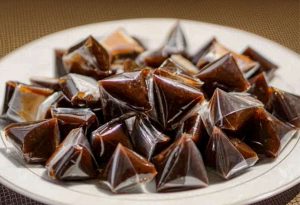
Origins and History:
Dodol, a traditional Malaysian confectionery, has a fascinating journey that dates back centuries. It gained popularity during the spread of Islam in the Malay Archipelago, thanks to traders from India and the Middle East who brought their cultural and culinary influences. The name “dodol” originates from the Hindi word “duldul,” meaning to mix or blend, which perfectly describes the sticky and chewy texture achieved through hours of continuous stirring. The communal preparation of dodol during festivals and celebrations fostered social cohesion and bonding among communities. It became an integral part of festivities like Hari Raya Aidilfitri, symbolizing the joyous end of Ramadan and a shared tradition among Malays.
Ingredients and Preparation Process:
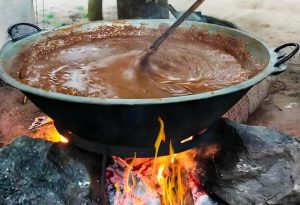
Dodol is made using glutinous rice flour, coconut milk, and palm sugar as its primary ingredients. These ingredients are carefully combined through a labor-intensive process of stirring and cooking over a slow fire for hours. The mixture is constantly stirred to prevent burning and sticking, requiring teamwork and patience. Once thickened to the desired consistency, tapioca flour is added to bind the dodol and enhance its chewy texture. The whole preparation process can take up to 12 hours or longer. The unique texture and caramelized flavor achieved through dedication and constant stirring have become integral parts of dodol’s cultural heritage and significance.
Cultural Significance and Unique Traditions:

Dodol holds a special place in Malay culture and is deeply embedded in Malaysian and Singaporean traditions. It is considered a prestigious gift and is commonly made and shared during festive occasions, particularly Hari Raya Aidilfitri. The communal activity of making dodol strengthens family bonds and promotes a sense of community. Giving dodol to friends, family, and neighbors during Hari Raya emphasizes the values of cooperation, kinship, and celebration. Different regions have developed their own unique styles of dodol, incorporating flavors like durian, coconut, and arenga pinnata made with sugar palm sap.
Modern Innovations:
While traditional dodol making is still popular, modern technology has simplified its production process and introduced new flavors. Large steam jacketed kettles and specialized dodol production lines with conveyor belts have improved consistency and efficiency. Additionally, unique flavors such as chocolate, coffee, honey, and pandan have been introduced, providing a modern twist to the classic dodol taste. Limited edition seasonal dodols in flavors like mango, jackfruit, and lychee are also gaining popularity.
Fun Facts About Dodol
Making dodol is a labor of love that requires patience and dedication. Here are some interesting facts about this sweet Malay confection:
- It can take up to 10 hours to make a single batch of dodol! The cooking process involves constantly stirring and reducing the coconut milk mixture over low heat. Dodol masters often take turns stirring to avoid fatigue.
- Dodol is especially popular during festive seasons like Hari Raya Aidilfitri. Families and villagers come together to make large batches to share. It’s estimated that over **500 metric tons** of dodol are produced annually just for Hari Raya!
- The intricate process of preparing dodol is said to signify the community cooperation and family bonding of the celebration. Strangers are even welcomed to take turns stirring the pot!
- Traditionally dodol was cooled in wooden trays, which led to its unique texture. Modern dodol makers sometimes use plastic trays for convenience.
- Dodol has a very long shelf life due to its low moisture content. It can last months without refrigeration if stored properly. Some say you can even eat decades old dodol if it wasn’t exposed to moisture!
- Malacca and Penang are famous for their dodol, with distinctive styles. Malaccan dodol has a firm, chewy texture while Penang dodol is softer and stickier.
- Creative flavors like durian, coffee, and chocolate dodol have become popular. But traditional coconut milk dodol still reigns supreme for purists.
- Dodol is notoriously difficult to eat at first! The sticky, chewy texture takes some getting used to. Locals suggest letting it melt on your tongue before chewing.
Conclusion:
From its humble beginnings to becoming a cultural icon, dodol has come a long way. Its journey reflects the evolution of Southeast Asian food traditions and signifies the importance of community and celebration. Dodol’s sticky and chewy texture, rich flavor, and communal preparation continue to connect generations to their heritage. Whether enjoyed during Hari Raya or as a gift exchanged among loved ones, dodol encapsulates the essence of Malay culture and the joyous spirit of Malaysian festivities.



